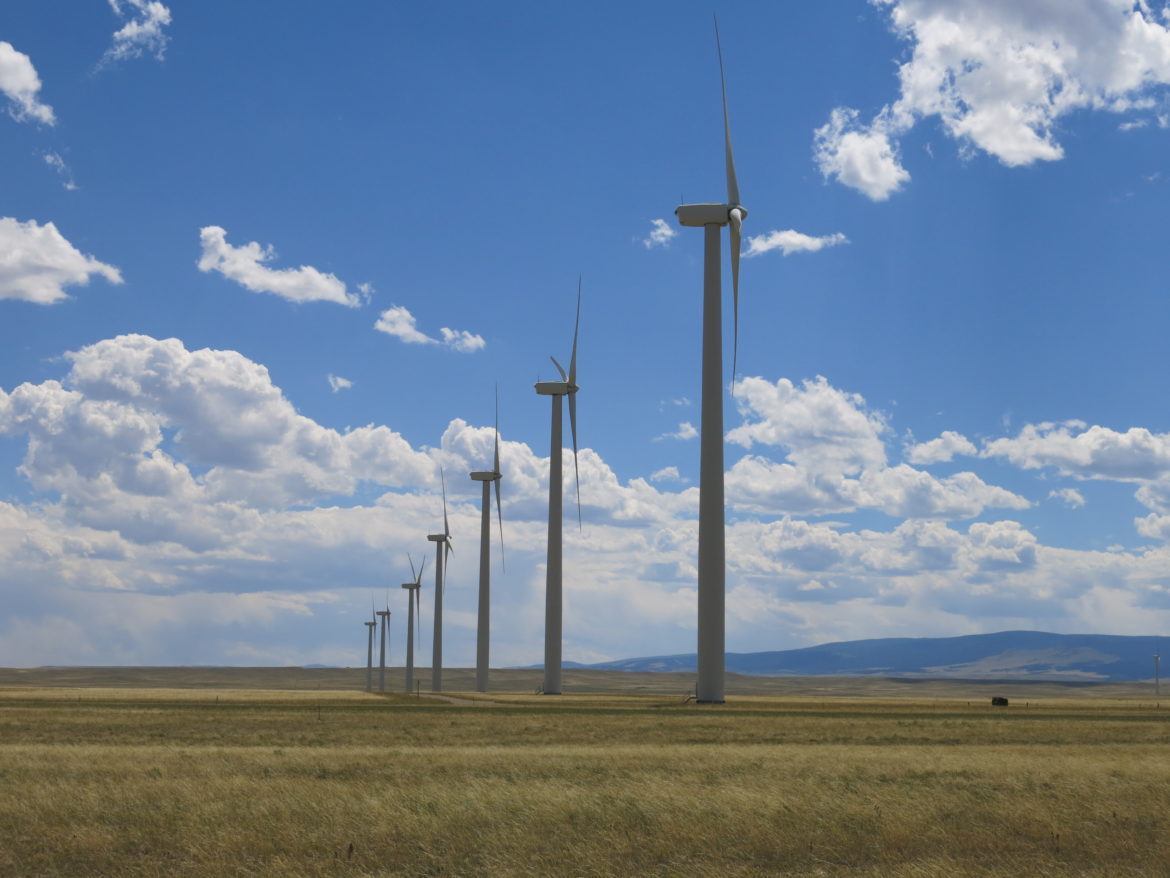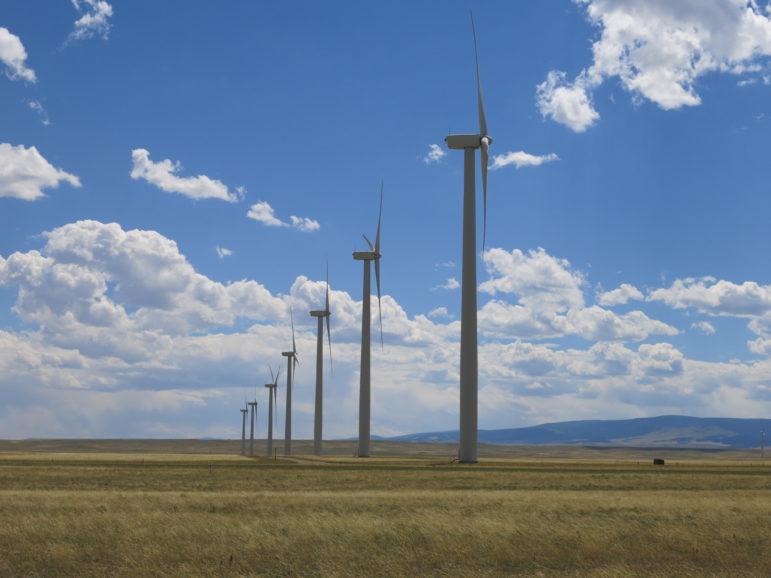
Wind turbines are pretty sleek-looking from a distance, but there’s a lot going on behind those spinning blades.
Bryan Boatright, a wind energy technology instructor at Laramie County Community College, took me up into a deconstructed nacelle. A nacelle is a big rectangular box that holds generation components like the generator and drive train. Each one looks like an RV.
Boatright trains his students to fix the parts housed in the nacelle. Many of those students go on to be wind turbine technicians. That’s the fastest growing profession in the country, according to the Bureau of Labor Statistics, and a profession and industry that Wyoming would sorely like to attract.
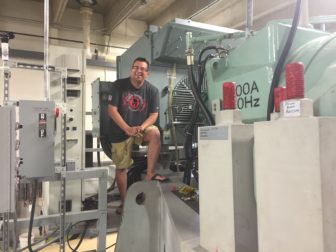
Leigh Paterson / Inside Energy
Bryan Boatright is an instruction in Wind Energy Technology at Laramie County Community College.
But there’s a problem. As of 2014, there were only around 4,400 wind turbine technician jobs nationwide, and only a handful in Wyoming. In comparison, the number of people who work in wind turbine manufacturing is around 20,000, according to data compiled by the American Wind Energy Association.
Boatright and others see potential.
“Bringing manufacturers to this state would be probably one of the most incredible things you could ever do in the state of Wyoming right now, as the short term band-aid to stop the bleeding on what we see from the outside as coal in its demise,” Boatright said.
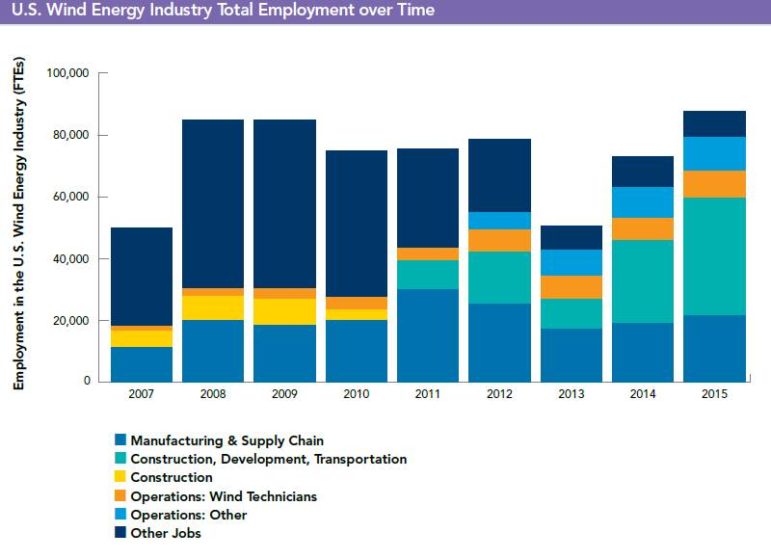
Wyoming has lost hundreds of coal mining jobs this year. But the renewables industry is growing nationwide. Generation capacity is projected to jump more than 50 percent by 2040, even in the absence of new environmental regulations requiring renewables. With that growth a need for more components like blades and towers to build wind farms.
Wyoming Gov. Matt Mead’s long term energy strategy for the state includes plans to attract this kind of manufacturing.
But there are some big barriers to bringing manufacturing to Wyoming, like a small available workforce in the state and long distance to an international airport. That’s according to Ben Avery, director of the business and industry division for the Wyoming Business Council. There’s also a political barrier to growing the wind industry as a whole: the state’s tax on wind production.
“It is interesting, when we’re at American wind industry [conferences], one thing that everybody knows about, everybody makes the comment. Oh you’re Wyoming, you’re the only state that has a tax on wind. Everyone says that. And that’s not positive,” Avery said.
As we’ve reported in the past, Wyoming is actually considering raising that tax.
Right now, Wyoming doesn’t have any wind manufacturing. But just across the border in Colorado, it is a very different scene. Over the past six years, the state has become a wind manufacturing hub. The state has 20 of these facilities, according to AWEA.
I visited a factory owned by the Danish wind giant Vestas in Brighton, CO which opened in 2010. Vestas is the largest wind manufacturer in Colorado and employs 3,500 workers statewide.
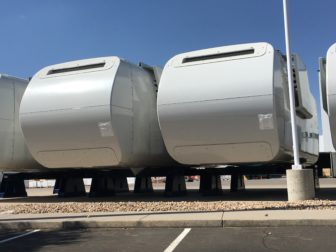
Amy Sisk / Inside Energy
Nacelles, manufactured by Vestas, lined up outside of the company’s Brighton, CO facility.
Chris Welsh, an enthusiastic, fast-talking production manager, showed me around the vast factory floor where workers build the massive nacelles as well as another gigantic part called a hub.
The process of making these components is straight assembly.
“To see something like that, that size, that scale and the technology behind that to be able to manufacture that and put that out the door with honestly average men and women that are producing these. We do have good skill sets but it’s not great skills sets like master electricians and foremen from construction sites,” Welsh said.
Vestas’ Brighton workforce includes everyone from ex-teachers to convenience store workers.
Vice president and factory manager Scott Winner says Vestas chose to set up shop in Colorado because of access to rail networks, proximity to wind projects and an available labor force.
When I asked how much workers here make, trying to figure out what these jobs mean for the local economy, Winner couldn’t comment. He did say that media reports of $16.95 or more per hour benefits are “in the ballpark.”
As communities across the country try to figure out how offset some of the job losses in fossil fuels, wages matter. The average Wyoming coal miner — the folks who are losing jobs by the hundreds — make around $34 an hour. So, even if wind factories did move across state lines, this shift alone wouldn’t come close to replacing coal.
What’s Next:
- Southern Wyoming could be home to the largest wind farm in North America. Read more here.
- What does the inside of a wind turbine actually look like? Check out the Department of Energy’s handy drawings.
- Can California and Wyoming share renewable power? Stephanie Joyce reports that it is a complicated coupling.
